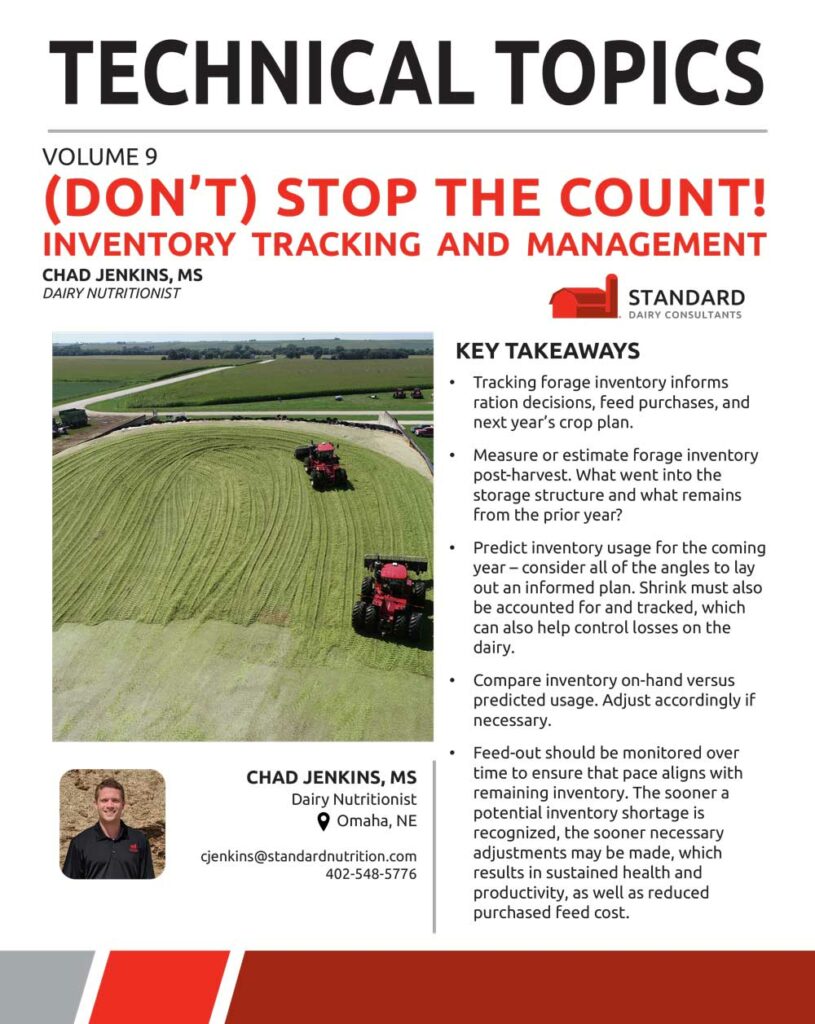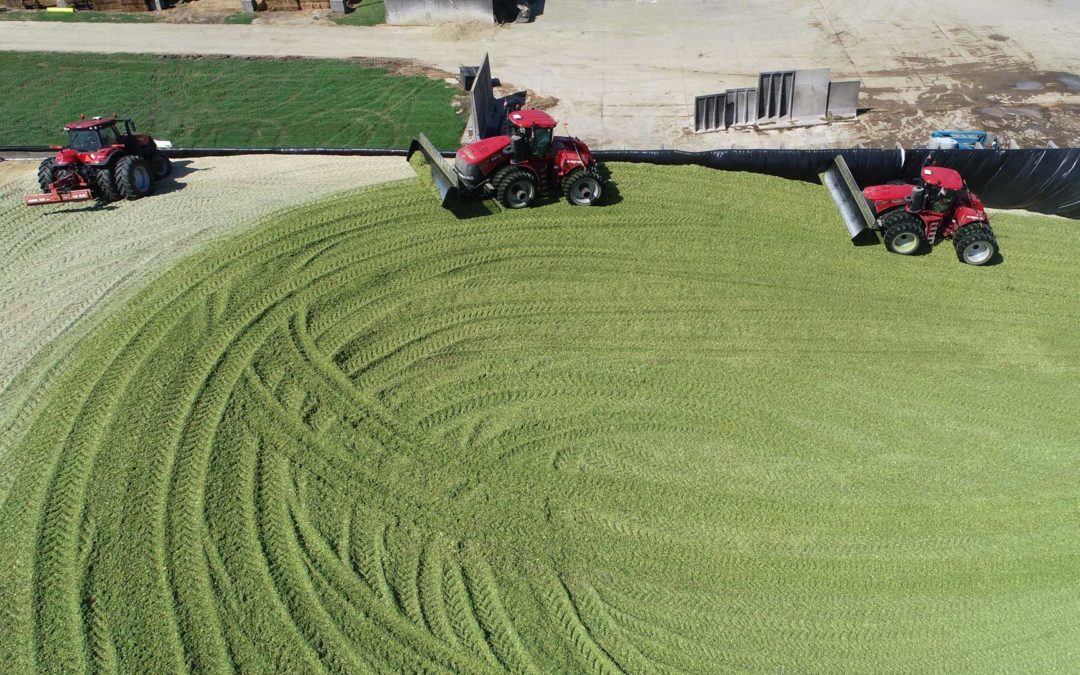Written by: Chad Jenkins, MS
KEY TAKEAWAYS IN THIS ISSUE OF TECHNICAL TOPICS:
- Tracking forage inventory informs ration decisions, feed purchases, and next year’s crop plan.
- Measure or estimate forage inventory post-harvest. What went into the storage structure and what remains from the prior year?
- Predict inventory usage for the coming year – consider all of the angles to lay out an informed plan. Shrink must also be accounted for and tracked, which can also help control losses on the dairy.
- Compare inventory on-hand versus predicted usage. Adjust accordingly if necessary.
- Feed-out should be monitored over time to ensure that pace aligns with the remaining inventory. The sooner a potential inventory shortage is recognized, the sooner necessary adjustments may be made, which results in sustained health and productivity, as well as reduced purchased feed cost.

Inventory Tracking and Management
So the dust has finally settled on the feed pad; bunkers are full, piles are covered, and silos are capped. Acre on an acre of a season’s worth of hard work has been gathered and stored, ready to fuel the cows for the year ahead. While harvest itself is no easy chore, determining forage inventory and divvying up feed-out rates may seem a daunting task after the last chopper has been parked. Fortunately, with a little foresight and a few simple tips, getting a handle on forage inventory can be an uncomplicated undertaking that yields several benefits beyond a simple understanding of “what’s on the pad”.
Determining Initial Inventory
The first step to any forage feed-out plan is determining the beginning inventory. There are as many and more methods for estimating initial inventory as there are structures and methods to store forage. At the core of these methods is some simple geometry we all have encountered at one time or another in our school days:
Volume (cubic feet) x Density (pounds per cubic feet) = Pounds of feed
Understanding the storage capacity of a structure or a pile means first understanding its volume. This is an easier calculation for some structures than others. Consider the good old upright silo, which is simply the volume of a cylinder, calculated using the height of the forage therein (volume = πr2h). Bunker silos and drive-over piles become more complex, as the shape may become increasingly dynamic depending on the artistry of your packing tractor drivers. In this case, your Standard Dairy Consultant has access to spreadsheets and calculators that allow for the estimation of volume using a handful of straightforward measurements.
The next variable required for determining the beginning inventory is density. Density is correlated with the “pack” achieved and is typically expressed as lbs of DM/ft3. The minimum recommended density for hay crops and corn silages is in the neighborhood of 16 lbs DM/ ft3. With reasonable confidence in packing technique and protocols, 16 lbs DM/ft3 can be a conservative place to start if unknown. Based on methods used to measure the inventory feed-out rate discussed later, the density variable can be adjusted should the actual feed-out rate (inches/day) conflict with what is expected.
Alternatively, density may also be measured directly by driving a hollow rod of a known volume into the face of the pile. The material collected is weighed, corrected for dry matter, and expressed as dry matter pounds per unit volume. Especially in larger piles, this process involves the inherent safety concern of triggering a silage avalanche. An advisable approach is to work with your consultant or industry partners who have access to a density probe designed to safely complete this process – the probe attaches to the bucket of a skid-steer or front-end loader in order to allow the operator to safely approach and puncture the face of the pile. In addition to providing the density variable needed to calculate total pounds of feed, density also serves as an indicator of the quality of the pack achieved – more densely packed bunkers limit oxygen, resulting in desirable, anaerobic fermentation and subsequent feed stability and reduced dry matter loss.
Predicting Inventory Usage
Here in the Thanksgiving season, many of us are beginning to dream up the dinner menu and ingredients needed for an enjoyable meal with family. Do we need the 10 or 20-lb turkey? How many pumpkin pies? How much beer is required to sedate Uncle Frank? Not unlike the thanksgiving menu plan, it is prudent to estimate the predicted consumption of forages over the course of the year to ensure a consistent and productive ration for the cows, as well as to minimize purchased feed cost. While it is impossible to forecast exact usage given fluctuations in cow number, intakes, and ration changes, work with your nutritionist and draw from past experience to come up with your best prediction (S.W.A.G. method). Feeding software may also be a helpful 3 tool to forecast usage – most feeding software will project inventory usage based on current rations.
Here are some potential questions to ask to aid in this determination: what is our typical forage-to-concentrate ratio? What is our typical corn silage to haylage ratio? Do any initial forage analyses indicate that we should be feeding more or less of a particular feed? Are we planning on adding (or removing) a number of cows this year? How has our dry matter intake changed historically over the course of the year? Are there any economically advantageous opportunities to contract commodity or by-product feeds that replace forage for a portion of the year?
Another important factor in predicting inventory usage is shrinking. Let us return briefly to the Thanksgiving analogy. I like roughly a pound of mashed potatoes and gravy on my plate — of that pound, about an ounce or more may end up festooned on my holiday sweater instead of in. my mouth; this is shrinking (about 6% in this case). Shrink on the dairy may result from spoiled feed, feed spilled or blown away during mixing or delivery, or any other reason that feed doesn’t make it from the pile to the cow’s mouth. Though a difficult metric to track, shrink may be estimated year over year as the difference in initial inventory versus that which was actually fed out. A conservative estimate for a well-managed herd maybe somewhere in the ballpark of 10% or less. In addition, to feed expected to be consumed by the cows, the total anticipated shrink must be accounted for in predicted inventory usage.
Once overall predicted usage has been determined (forage consumed + shrink), compare it against the estimated inventory on-hand. Ideally, enough forage is available to support a year’s worth of feeding, plus three months of carryover for corn silage and three weeks for alfalfa silage (next season’s harvest). A carryover period is important for ensiled feeds in order to allow time for anaerobic fermentation to occur, improving feed stability and nutrient availability at feed-out. Consider making ration adjustments or discuss forage-extending ingredients with your nutritionist should inventory fall well short of predicted needs.
Monitoring Inventory Usage
After the initial inventory has been determined and a plan set in place for usage, a worthwhile practice is to monitor feed-out progress over the course of the year. A few simple methods can go a long way in ensuring feed-out remains at the expected pace.
A rudimentary but effective method for tracking forage inventory usage is simply marking a line with spray paint on the feed pad or bunker wall in-line with the face of the silage, and a week later, measuring the distance covered between the line and the new location of the face; divide the distance by 7, and you are left with an estimate of current inches/day of feed-out. The remaining length of the pile may then be divided by inches/ day of feed-out, resulting in a prediction of days remaining. Keep in mind, it will take roughly half as much time to feed out the “toe” of a drive-over pile. A variation of this method may also be utilized on ag-bags; mark a line on the bag 10 feet from the opened end. After a week of feeding, measure the distance remaining to the marked line to determine the distance fed out.
Secondly, feed software does an excellent job of tracking and projecting inventory usage. Pounds of feed used are constantly updated based on actual feed weighed on the mixer scale. In addition, in programs like EZ Feed or FeedWatch, dry matter changes, ration adjustments, or changes in pen counts will affect the projected usage of a particular feed, which may be extrapolated over a given number of days. This is a helpful feature in determining if certain ration adjustments are feasible as regards remaining inventory on hand.
Finally, feeding software may be combined with the method of direct measurements described above. Because feeding software lists actual pounds of forage used in a day, pounds per foot of silage pile may be estimated; determine the number of days it takes to cover one foot, and then multiply by pounds of the forage used per day as determined by the feeding software. This information may be used to correct estimated forage inventory in a pile or bunker by measuring the remaining length of the pile.
Should discrepancies be identified between the adjusted remaining inventory and the usage plan, it is imperative to make the appropriate ratio changes as quickly as possible. Tracking feed-out pace can serve as an “early warning system” where prompt interventions can prevent dramatic changes that would otherwise negatively affect cow health, productivity, and purchased feed cost.
Looking Ahead
Getting a handle on forage inventory year-over-year provides invaluable insight for cropping, nutritional, and economic decisions. While inventory estimates or usage projections are never exactly perfect, they serve as a useful roadmap to keep us on track and to prevent feed shortages prior to harvest, which is not only detrimental to the checkbook but often to milk production performance as well. Accordingly, tracking and keeping inventory records allows us to make more informed decisions as well as to learn from our mistakes… like my gravy-stained holiday sweater.


